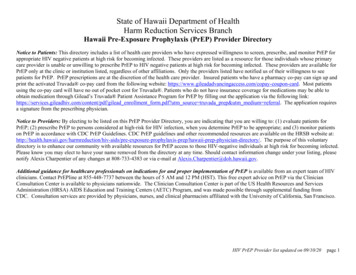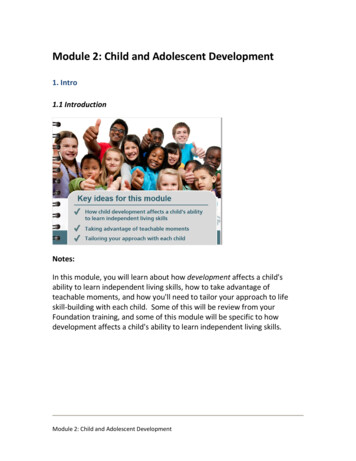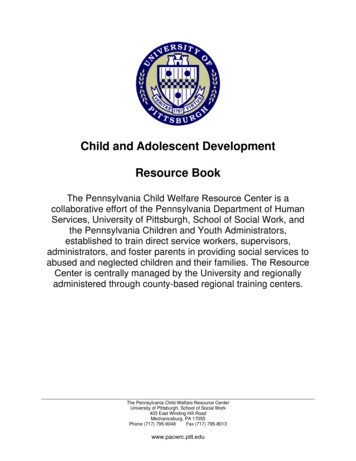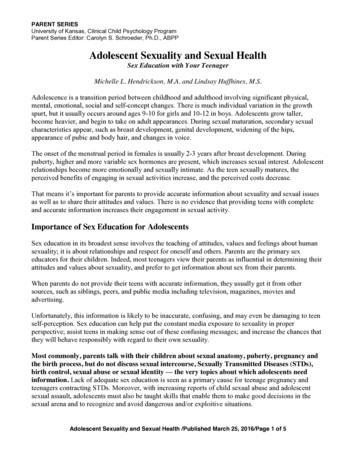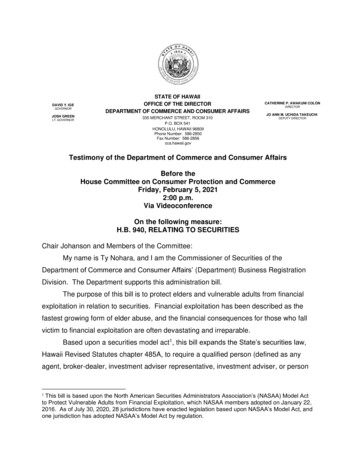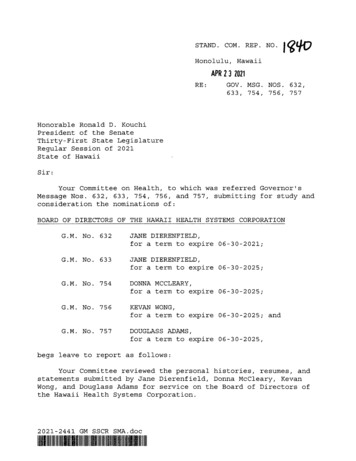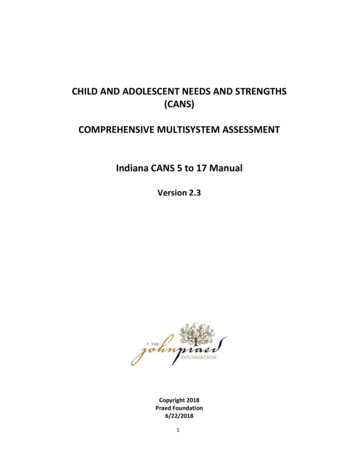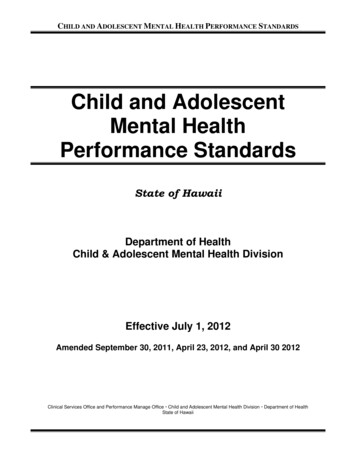
Transcription
CHILD AND ADOLESCENT MENTAL HEALTH PERFORMANCE STANDARDSChild and AdolescentMental HealthPerformance StandardsState of HawaiiDepartment of HealthChild & Adolescent Mental Health DivisionEffective July 1, 2012Amended September 30, 2011, April 23, 2012, and April 30 2012Clinical Services Office and Performance Manage Office x Child and Adolescent Mental Health Division x Department of HealthState of Hawaii
CHILD AND ADOLESCENT MENTAL HEALTH PERFORMANCE STANDARDSTABLE OF CONTENTSINTRODUCTION. vSECTION I: GENERAL PERFORMANCE STANDARDS . 1OVERVIEW . 2A. CORE COMPONENTS OF CURRENT CAMHD SYSTEM . 21. Commitment to Hawai’i CASSP Principals . 22. Commitment to Interagency Collaboration and Coordination . 23. Commitment to Evidence-Based Practices . 2a. Definition of Evidence-Based Practices . 3i. General Service Research . 3ii. Case-Specific Historical Information . 3iii. Local Aggregate Evidence . 3iv. Causal Mechanism Evidence . 44. Commitment to Performance Monitoring . 45. Commitment to Access and Continuity of Care . 46. Medical Necessity. 57. CAMHD Clinical Model . 5a. Clinical Lead . 5b. Branch Utilization Review Team . 6c. Threshold . 6B. ACCESS & AVAILABILITY . 61. Educationally Supportive (ES) Intensive Mental Health Services . 62. Support for Emotional and Behavioral Development (SEBD) Services . 7C. COORDINATION. 7D. EVALUATIONS . 81. Mental Health Evaluation . 82. Psychosexual Assessment . 9E. CO-OCCURRING DISORDERS. 9F. SERVICE PLANNING . 91. Coordinated Service Plan (CSP) . . 92. Mental Health Treatment Plan (MHTP) . 10a. Crisis Planning . 10b. Discharge Planning . 10c. Discharge Summary. 11G. REFERRAL PROCESS FOR CONTRACTED SERVICES . 111. CAMHD Referrals . 11a. Outpatients Referrals . 11b. Out of Home Referrals . 122. Contractor Referral Acceptance Protocol . 12H. CONTINUITY OF CARE. 13I. STAFFING . 141. Orientation and Training Requirements for CAMHD Contractors . 14i
CHILD AND ADOLESCENT MENTAL HEALTH PERFORMANCE STANDARDSJ.K.L.M.N.O.P.Q.R.S.T.2. Orientation and Training Requirements for CAMHD Employees . 16SUPERVISION . 17EVALUATION OF STAFF PERFORMANCE . 18CREDENTIALING REQUIREMENTS. 181. Qualified Mental Health Professional (QMHP). 192. Mental Health Professional (MHP) . 193. Teachers in Community . 194. Paraprofessional. 20MEDICATION MONITORING . 20MAINTENANCE OF SERVICE RECORDS . 211. Progress Notes . 21SERVICE QUALITY . 23MINIMUM REPORTING REQUIREMENTS . 231. Monthly Treatment and Progress Summary (MTPS) . 232. Quality Assurance (QA) Reports . 24QUARTERLY QA REPORT . 24a. Sentinel Events . 24b. Clinical Supervision . 24c. Clinical Documentation . 24d. Facility (if applicable) . 25e. Highlights of Significant Finding/Accomplishments . 25f. Status of Corrective Action/Improvement Plans. 25g. Contractor Quality Assurance Meeting Agenda and Minutes. 253. Facilities Information Requirements. 254. CAMHD Summary of Licensing Corrective Actions/Required Deliverables . 255. Sentinel Events. 266. CAMHD Accreditation . 267. CAMHD Weekly Census Report on Client Status and Waitlisted Youth . 268. CAMHD Attendance and Encounter Records . 269. CAMHD Title IV-E Administrative Reports . 2610. Other specified reports/documents periodically requested by CAMHD . 26RISK MANAGEMENT . 261. Criminal, Child Abuse, and Background Screening . 262. Safety . 273. Restraints and Seclusions . 27Orders . 29Monitoring . 29Assessment after the Initial Intervention . 30Notification . 30Debrief . 314. Sentinel Events and Incidents . 315. Police . 32YOUTH RIGHTS AND CONFIDENTIALITY . 32CAMHD Consumer Rights . 32COMMUNITY FOCUS . 33TEAM-BASED DECISIONS . 33ii
CHILD AND ADOLESCENT MENTAL HEALTH PERFORMANCE STANDARDSU. GRIEVANCES/APPEALS . 33V. ACCOUNTABILITY/SERVICE STANDARDS . 34W. BEDHOLDS AND THERAPEUTIC PASSES . 341. Bed Holds . 342. Therapeutic Passes . 34SECTION II: SERVICE SPECIFIC PERFORMANCE STANDARDSSECTION II – PART A: EMERGENCY MENTAL HEALTH PERFORMANCE STANDARDSI.Emergency Mental Health Services. .2. 24-Hour Crisis Telephone Stabilization .3. Crisis Mobile Outreach .4. Therapeutic Crisis Home .36374044SECTION II – PART B: EDUCATIONALLY SUPPORTIVE INTENSIVE MENTAL HEALTH SERVICES FORIDEA PERFORMANCE STANDARDSII.Educationally Supportive Intensive Mental Health Services . 49A. Ancillary Services . 50B. Respite Supports . 53C. Psychosexual Assessment . .55D. Functional Family Therapy . .59E. Multisystemic Therapy . .65F. Intensive In-Home Therapy . .71G. Intensive In-Home Paraprofessional Support . .79H. Intensive Independent Living Skills . .85I. Independent Living Skills Paraprofessional Support. .94J. Therapeutic Respite Home . 100K. Multidimensional Treatment Foster Care. 104L. Transitional Family Home . 111M. Community-Based Residential Level III . 119N. Community-Based Residential Level II . 128O. Community-Based Residential Level I . 137P. Hospital-Based Residential . 147SECTION II – PART C: SUPPORT FOR EMOTIONAL AND BEHAVIORAL DEVELOPMENT PERFORMANCESTANDARDSIII.Support for Emotional and Behavioral Development Services . 156A. Mental Health Evaluation . 157B. Psychological Testing . 162C. Summary Annual Evaluation . 165D. Psychiatric Evaluation . 169E. Medication Management . 173F. Individual Therapy . 177G. Group Therapy . 182H. Family Therapy . 187I. Partial Hospitalization . 192iii
CHILD AND ADOLESCENT MENTAL HEALTH PERFORMANCE STANDARDSSECTION III: APPENDIX . 200IV.Appendix Documents . 2011. CASSP Principles . 2022. Youth Mental Status Checklist Form . 2033. EPSDT – Elements of EPSDT Screens and Periodicity Schedule . 2064. Referral Acceptance Protocol Policy and Procedure 80.614 . 2075. Referral Acceptance Form . 2136. Independent Psychiatrist Consultation Form . 2147. Support for Emotional and Behavioral Development (SEBD) Fact Sheet . 2158. Therapeutic Foster Home Profile Form . 2189. Sentinel Events Policy and Procedure 80.805 . 21910. 72-Hour Sentinel Events Report Form . 22411. Sentinel Event Code Definitions . 22912. Weekly Census Report on Client Status . 23513. Waitlisted Youth Form. 23614. Contracted Agency Quarterly Training Report . 23715. Child Abuse and Neglect Check Policy and Procedure 80.406 . 23816. Initial and Re-credentialing of Licensed QMHPs Policy and Procedure 80.308 . 24217. Grievances and Grievance Appeals Policy and Procedure 80.603 . 25718. Safety Plan . 27919. Initial and Re-credentialing of MHPs and Paraprofessionals P&P 80.308.1 . 28120. CAMHPS Acronym List . 293iv
CHILD AND ADOLESCENT MENTAL HEALTH PERFORMANCE STANDARDSINTRODUCTIONThe Child and Adolescent Mental Health Performance Standards (CAMHPS) is a manualdeveloped by the Hawai’i State Department of Health (DOH), Child and Adolescent MentalHealth Division (CAMHD) for use in the development and provision of behavioral healthservices for youth. This manual is part of the contractual agreement between CAMHD and itcontracted provider agencies for delivering behavioral health services to youth and familiesin Hawai’i. These standards and guidelines are designed to define service content standards,and to assure the efficiency and effectiveness of services.The CAMHD through its six (6) Family Guidance Centers and a Family Court Liaison Branch, hereinafter referred to as Branches, provide case management services to youth and families throughout thestate through the assigned Care Coordinator. In addition to the case management services, CAMHDemploys licensed clinical staff who provide treatment and clinical oversight for their respectiveBranch. CAMHD also has the ability to procure needed services from its contracted provider agenciesto meet the treatment needs of youth. CAMHD provides services to youth who a) have been certifiedas qualifying under the Individuals with Disabilities Educational Act (IDEA) for special educationservices and who are in need of related mental health services to benefit from their free andappropriate public education; and b) youth who meet the eligibility requirements for CAMHD’s Supportfor Emotional and Behavioral Development (SEBD) program.This current manual is a departure from pervious versions as it is not an interagency manualcollaboratively written with the Department of Education (DOE). Since July of 2002, CAMHD and theDOE have collaborated to produce three versions of the Interagency Performance Standards andPractice Guidelines (IPSPG), also know as the blue, green and purple books referring to color of thecover and representing the year it was published. With each revised version of the IPSPG, the manualhas become more technical, and it has served as the basis for CAMHD contractual requirements forproviders. As a result, this version has been produced without the usual collaboration with theDOE. Despite this departure, CAMHD remains committed to working with the DOE in providingbehavioral health services to youth in need.The CAMHPS is designed to define the required content for each of the array of services CAMHDprovides through its contracted provider agencies. Unless granted a written waiver from CAMHD, allcontracted providers agencies, their employees and subcontractors are required to comply with theirspecific contracts which delineate additional requirements for each service.v
CHILD AND ADOLESCENT MENTAL HEALTH PERFORMANCE STANDARDSvi
SECTION I:GENERAL PERFORMANCE STANDARDS
CHILD AND ADOLESCENT MENTAL HEALTH PERFORMANCE STANDARDSSECTION I: GENERAL PERFORMANCE STANDARDSOVERVIEWThe General Performance Standards are requirements for all Child and Adolescent Mental HealthDivision (CAMHD) services, and apply to each of the specific services. They are set forth to guideeffective practices in the delivery of behavioral health supports and services for eligible youth in theState of Hawai’i. In Hawai’i’s integrated system, supports and services are provided in accordancewith all regulations as required by Individuals with Disabilities Educational Improvement Act 2004(IDEA) and Medicaid with active involvement of families and communities in alignment with theHawai’i Child and Adolescent Service System Program (CASSP) principles (See Appendix 1).CAMHD reserves the right to amend this book in the future by adding new services or revisingexisting services as necessary to meet the needs of the youth of Hawai‘i. Any and all changes thatmay occur in the future will be posted on the CAMHD website: html. Additionally, CAMHD will periodically revise its policies and procedures tocomply with department policies, changing laws, regulation and rules as required. All contractorswill be notified of any policy and procedure change that may affect their operations.A. CORE COMPONENTS OF CURRENT CAMHD SYSTEMThese core components underlie the values CAMHD strives to operationalize in its practices. TheCAMHD expects the same commitment from contractors to support these components in theirrespective practices.1. Commitment to the Hawaii CASSP PrinciplesNationally, the CASSP principles (Stroul, B.A. and Friedman, R.M., 1986) were developed inaccordance with the original work of Jane Knitzer in an effort to provide a framework ofprinciples for newly created systems of care. Early in the 1990s, Hawaii communities andstakeholders made minor language revisions to these CASSP principles to effectively addressthe relevant cultural issues as they presented in Hawaii. CAMHD is committed to the CASSPPrinciples (See Appendix 1) and expects the same commitment from contracted providers.2. Commitment to Interagency Collaboration & CoordinationMost of the youth served by CAMHD attend public schools, and may be involved with the childwelfare system, juvenile justice system, or other DOH Divisions, including Alcohol & Drug Abuse(“ADAD”), Developmental Disabilities Division (“DDD”), and Early Intervention Services (“EIS”).A large percentage of the CAMHD population is enrolled in QUEST Healthplan services, whichrequires linkages to the primary healthcare providers. The CAMHD system is committed towork with all other child-serving agencies to integrate services and programs across agencies inthe best interest of youth and their families.3. Commitment to Evidence-Based PracticesMental health services provided within the CAMHD system are expected to be evidence-based.Interventions with youth are meant to incorporate elements of those treatments identified asmost promising based on credible scientific data. The proposed array of services provides amedium through which evidence-based interventions can be applied at high levels of intensityand in a variety of settings, depending on the needs of the youth. The CAMHD regularlyreviews, summarizes, and disseminates relevant research data to support agencies in theirselection and implementation of services. All treatment planning for psychosocial andPage 2General Performance Standards
CHILD AND ADOLESCENT MENTAL HEALTH PERFORMANCE STANDARDSpharmacological intervention should stem from careful consideration of the most currentresearch. In addition, agencies are encouraged to gather and evaluate their own data on childoutcomes and functioning to further inform clinical decisions and the design of appropriateinterventions. See the following links for the (a) CAMHD Biennial d/library/pdf/ebs/ebs013.pdf and (b) the evidencebased child and adolescent psychosocial intervention matrix from the American Academy 0503.pdfa. Definition of Evidence-Based PracticeCAMHD has required contractors to use evidence-based treatment approaches for manyyears, but there is still a lot of confusion about what this really means. In brief, evidencebased practices include all those treatment strategies and interventions for whichobservable, objective data exist demonstrating positive effects. Using evidence-basedtreatment means using interventions that have been shown to work. CAMHD contractedproviders are expected to utilize data about an individual youth’s progress along with thebest available information about “what works” in planning and revising treatment. The data(or evidence-bases) showing the positive effects of mental health treatment practices cantake one of four major forms, listed below in order of their relative strength. Informationabout the evidence base for various practices should be utilized throughout the course oftreatment to make clinical decisions. Higher priority should be given to more reliable orstronger forms of evidence in making treatment decisions.i.General Services ResearchGeneral service research is data typically found in peer-reviewed scientific journals (e.g.,in the form of randomized clinical trial outcomes), and summarized in reports such as theBlue f and Practice Element Profiles in the latest CAMHD Biennial d/library/pdf/ebs/ebs013.pdf. Defined thisway, evidence-based practice can include large brand-named packaged protocols (e.g.,Multisystemic Therapy), broad-based therapeutic approaches (e.g., Cognitive-BehavioralTherapy) and discrete clinical techniques or practice elements (e.g., CaregiverPsychoeducation). When there is limited or weak published research evidence about aparticular approach, but it appears promising, the strategy is often referred to as a “bestpractice.”ii. Case-Specific Historical InformationCase-specific historical information is case-specific data from repeated clinicalinteractions in the form of standardized (e.g., Ohio Scales, CAFAS, BASC, ASEBA) oridiographic (individualized) assessment strategies (e.g., MTPS ratings, mood or SUDSratings, etc.). The usefulness of such data increases as the number of routineassessment points increases over time, and the data can be displayed graphically tohelp demonstrate strategies that are helpful to an individual youth on a case-by-casebasis.iii. Local Aggregate EvidenceLocal aggregate evidence is case-specific data aggregated across numerous youth intomeaningful composite units, such as treatment facilities. Such evidence includes notonly positive clinical outcomes (e.g., a specialty facility may have high rates of successwith youth with severe substance abuse concerns), but also critical incidents (e.g., acertain facility may have higher than average elopement rates, and care should be takenPage 3General Performance Standards
CHILD AND ADOLESCENT MENTAL HEALTH PERFORMANCE STANDARDSbefore youth at risk for elopement are placed there). These types of data are sometimesreferred to as practice-based evidence.iv. Causal Mechanism EvidenceMemory, judgment, and professional knowledge of team members regarding the variouscausal mechanisms associated with the developmental psychopathology and treatmenttrajectory associated with a youth. Many times, such expertise is sought to helpconstruct interventions for youth who have received empirically supported treatments buthave not yet met treatment goals. Say for example, that a team has an agreed-uponcase conceptualization that a youth’s treatment for her trauma is not progressingadequately because the youth has an overall poor sense of control over herenvironment. Therefore, in addition to exposure-based strategies, the team recommendsthat extra care should be taken for cognitive restructuring and parenting strategies thathelp the youth exert personal control over her environment. Given potential informationprocessing biases and other concerns associated with human memory and judgment,care should be taken when relying on this evidence-base and the other forms of dataabove should first be strongly considered.As outlined above, the term “evidence-based practice” extends well beyond brand-namepackaged programs such as Multisystemic Therapy, Functional Family Therapy, andMultidimensional Treatment Foster Care. As outlined in this definition, the term“evidence” can and should take on many forms.4. Commitment to Performance ManagementThe CAMHD is committed to ongoing evaluation of performance and the use of data to continuethe development and management of the system as well as to improve provider development.Its performance management practices involve an extensive system for examining performanceand using findings to make informed decisions about services and needed adjustments toprogram implementation. The CAMHD tracks and analyzes contractor performance data acrossall aspects of service delivery and care. CAMHD uses this information to determine how wellthe system is performing for youth, and how well youth are progressing. It is sensitive enoughto determine if the system is performing better or worse for certain populations, andcomprehensive enough to detect what aspects of care, and in what settings, problems may beoccurring. Services are monitored through tracking of trends and patterns found in utilizationand satisfaction data, and examinations of practice and quality of services.The CAMHD maintains an active quality assurance and improvement program and expects toachieve goals of the program through an annual work plan that maintains improvement activitiesand measures for each quality and assurance program objective. Participants, includingContractors, in the system shall engage in ongoing quality assurance activities to improve theirservices and integration with the system.5. Commitment to Access & Continuity of CareThe CAMHD has the belief that every child/youth is capable of recovery and resiliency. CAMHDseeks to promote individualized care which empowers youth and their families to achieve theirgoals, and maximizes their opportunities to live full lives in their own communities.The CAMHD is committed to the philosophy of providing treatment at the most appropriate andleast restrictive level of care necessary for effective and efficient treatment to meet the youth’sbio-psychosocial needs. We see the continuum of care as a fluid treatment pathway, whereyouth may enter treatment at any level and be transitioned to more or less intensive levels ofcare as their changing clinical needs dictate.
The Child and Adolescent Mental Health Performance Standards (CAMHPS) is a manual developed by the Hawai’i State Department of Health (DOH), Child and Adolescent Mental Health Division (CAMHD) for use in the development and provision of behavioral health services for youth. This manual
